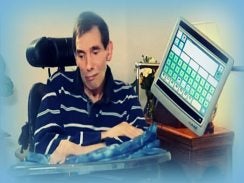Locked-in-Syndrome
Locked-in-syndrome (LIS) also known as cerebromedullospinal disconnection, pseudocoma or de-effented state, is a rare neuromuscular disorder involving total paralysis of voluntary muscles except for the (vertical) eyemuscles. The locked-in syndrome is a condition in which the patient is 'locked up' in his own body. He is aware of his surroundings, but cannot move or communicate through a complete paralysis. However rare cases of complete recovery have been documented but still the chances on motoric recovery are very limited.
Causes:
-
A stroke in the brainstem (pons)
-
A TIA (Transient Ischaemic Attack)
-
A brain hemorrhage
-
A high paraplegia
-
Diseases of the circulatory system
-
Traumatic Brain Injury
-
Diseases that destroy the myelin sheath surrounding nerve cells (MS, ALS)
-
Medication overdose
Locked-in-syndrome sufferers answer questions through eye movements, blinking or pupil dilatation


Three versions:
- The classical type refers to total paralysis and inability to speak, but communication via eye movement is possible.
- Incomplete LIS is like the classic type, but with more than just the remnants of motor eye movement.
- With a total LIS, there is still a full consciousness. The paralysis is complete, even the eyes or eyelids can not be moved.
The locked-in syndrome is not a disease but a description of the condition in which the patient resides. He/she is trapped in his own body there is a paralysis from a point between the eyes and the nose down.
Consciousness is fully preserved. The affected patients have almost always remained full senses.
They hear, see, feel, smell, taste and think; everything functions.
In most cases, the locked-in patient suffered no damage to the other parts of the brain.
Characteristics:
A Locked-in patient has no control over the cripple limbs (quadriplegia or tetraplegia)
Often one does not have good control over the facial muscles. Swallowing is often impossible. Reduced facial expression.
A specific feature is that the horizontal eye motion is disturbed, the eyes can only move from top to bottom and back.
Breathing problems often occur; control of breathing disappears or is very minimal.
The Diving Bell and the Butterfly trailer of the movie about LIS Frozen: A short film about Locked-in syndrome
|
The film depicts Bauby's life after suffering a massive stroke, on 8 December 1995, at the age of 43, which left him with a condition known aslocked-in syndrome. The condition paralyzed him from the neck down. Although both eyes worked, doctors decided to sew up his right eye as it was not irrigating properly and they were worried that it would become infected. He was left with only his left eye and the only way that he could communicate was by blinking his left eyelid. |
